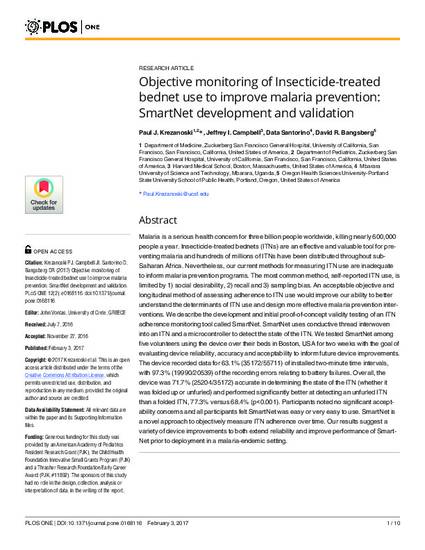
- Insecticides,
- Mosquito nets,
- Malaria -- Prevention,
- Public health,
- Health programs
Malaria is a serious health concern for three billion people worldwide, killing nearly 600,000 people a year. Insecticide-treated bednets (ITNs) are an effective and valuable tool for preventing malaria and hundreds of millions of ITNs have been distributed throughout sub-Saharan Africa. Nevertheless, our current methods for measuring ITN use are inadequate to inform malaria prevention programs. The most common method, self-reported ITN use, is limited by 1) social desirability, 2) recall and 3) sampling bias. An acceptable objective and longitudinal method of assessing adherence to ITN use would improve our ability to better understand the determinants of ITN use and design more effective malaria prevention interventions. We describe the development and initial proof-of-concept validity testing of an ITN adherence monitoring tool called SmartNet. SmartNet uses conductive thread interwoven into an ITN and a microcontroller to detect the state of the ITN. We tested SmartNet among five volunteers using the device over their beds in Boston, USA for two weeks with the goal of evaluating device reliability, accuracy and acceptability to inform future device improvements. The device recorded data for 63.1% (35172/55711) of installed two-minute time intervals, with 97.3% (19990/20539) of the recording errors relating to battery failures. Overall, the device was 71.7% (25204/35172) accurate in determining the state of the ITN (whether it was folded up or unfurled) and performed significantly better at detecting an unfurled ITN than a folded ITN, 77.3% versus 68.4% (p

Copyright: © 2017 Krezanoski et al. This is an open access article distributed under the terms of the Creative Commons Attribution License, which permits unrestricted use, distribution, and reproduction in any medium, provided the original author and source are credited.